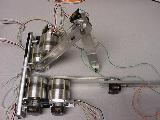

This project is no longer active. For current work, please refer to the RI research index.
Carnegie Mellon University > Robotics Institute > Garth Zeglin > Research > Bipeds
Quick Links: [publications] [biped photos] [biped movies] [RI Projects entry] [MPC5xx] [related work links]
We are developing bipedal walking robots that use dynamic walking principles. This is an evolving body of thought which has grown out of the history of passive-dynamic walking machines. Our goal is to produce efficient, robust walking machines. We believe it is important for efficiency to utilize the natural dynamics of the bipedal form as much as possible. We are seeking the best ways of using motors and control that complement the natural physics of swinging legs to add robustness.
This is joint work with Chris Atkeson, Garth Zeglin, Matthew McNaughton, Stuart Anderson, Mike Stilman, Jun Morimoto (at ATR), and Gordon Cheng (at ATR). We have also collaborated with Martijn Wisse (from TU Delft).
Chris Atkeson has some notes on his general research interests related to dynamic walking.
We have a page with a complete list of project-related publications.
The first machine is a biped with four actuators. It is mounted on a boom that constrains the body motion to three freedoms (x, z, pitch) and provides a means for sensing body position. The hip actuators are brushless DC servomotors directly mounted to the hip axles. The knee actuators are the same type of motor but use a small ratio cable reduction drive, however, they are still highly backdrivable.
The first work involved implementing an ad hoc walking controller at Carnegie Mellon. In January 2002 the planar biped achieved several runs in which it walked more than ten steps. This can be seen in the data plots (PDF) or in the video.
Subsequently the machine was shipped to ATR in Japan, where many learning controllers have been implemented.
The second machine is a biped with six actuators intended for full 3D motion. It is currently mounted on a boom that constrains the body to three freedoms (forward, up, and pitch rotation). The hip pitch joint and knee joint drive design is a refined version of the planar machine. The hip roll joint uses a combination of a DC gearmotor and a cable drive for higher torque, although the ratio is low enough to be backdriven by the weight of the leg when de-energized.
Various controllers have been implemented. Some simulation and experimental results are presented in the video.
More recently, Martijn Wisse added a passively-sprung foot that greatly eased walking.
The lab has also had a human-sized biped built for us by Sarcos.
Note: these photos are quite out of date; soon to appear are recent photos of the 3D Dynamic Biped
Here are a few rough photos of the planar machine.
 |
 |
Note: these clips are somewhat out of date; soon to appear are other recent clips of the 3DOF boom-constrained walking and more recent simulations.
Page revision: 2006/03/29 17:19:55.
Garth Zeglin, Robotics Institute, Carnegie Mellon University.